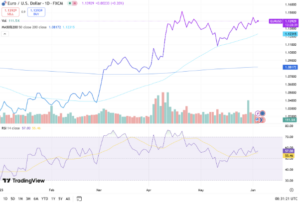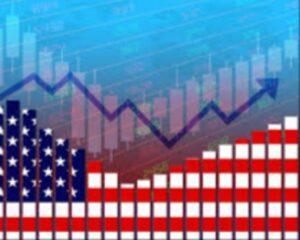On the first trading day of June, U.S. stocks showed resilience despite escalating global trade tensions. The S&P 500 rose by 0.41% to close at 5,935.94, while the Nasdaq Composite advanced 0.67% to 19,242.61. The Dow Jones Industrial Average added 35.41 points, or 0.08%, ending at 42,305.48. This came after a strong May, where all major indexes posted significant gains, with the Nasdaq leading the way.
Investors appeared to brush off renewed friction between the U.S. and China. Beijing rejected American accusations of trade violations and instead criticized Washington for failing to honor past agreements. This development followed a temporary 90-day tariff suspension after recent talks between Treasury Secretary Scott Bessent and Chinese Vice Premier He Lifeng. There is speculation that Presidents Trump and Xi might talk this week — a move markets hope will clarify future trade policy.
Meanwhile, tensions between the U.S. and the European Union also flared up. Trump announced plans to double steel tariffs from 25% to 50%, prompting a harsh response from the EU. European officials warned the move would damage economic cooperation and increase costs for consumers. Interestingly, steel stocks surged on this news, with Cleveland-Cliffs rising over 23% and both Nucor and Steel Dynamics jumping 10%.
Despite these trade concerns, market sentiment remained mostly positive. Analysts say that while uncertainty remains, there is cautious optimism that negotiations might stabilize, preventing any major shocks to the global economy.
In commodities, oil prices climbed sharply. West Texas Intermediate crude rose over 3%, trading above $62 per barrel, while Brent crude increased to nearly $65. This came after OPEC+ confirmed it would maintain its production increase of 411,000 barrels per day into July. Markets took comfort that the supply hike wasn’t larger, suggesting demand remains strong enough to absorb the new supply.
Gold and silver prices were relatively stable, while bitcoin-backed ETFs faced outflows. Friday marked the biggest daily outflow in months as investors grew nervous amid growing U.S.-China tensions and a declining crypto market.
On the economic front, new data showed that U.S. manufacturing remained in contraction territory in May, with the ISM index reading at 48.5. Construction spending also dropped 0.4% in April, highlighting continued weakness in some sectors.
Federal Reserve Chair Jerome Powell delivered remarks at a special conference but didn’t provide fresh policy insights. He paid tribute to the late former Fed Vice Chair Stanley Fischer and emphasized the importance of remaining data-driven in policy decisions. Meanwhile, Dallas Fed President Lorie Logan noted that current monetary policy remains well positioned, suggesting the Fed is prepared for either direction depending on how inflation and labor trends evolve.
In corporate news, Regeneron saw a slight stock bump after early results suggested its new drug could preserve muscle mass for users of obesity treatments. On the flip side, Tesla dropped 3% following weaker-than-expected sales in several European countries.
Traders are watching closely to see if this recent stock rally has legs or if renewed tariff pressure and inflation risks will curb momentum. JPMorgan analysts warned that the full effect of tariffs hasn't hit yet. Consumers may soon feel the pinch, possibly weakening economic activity in the coming months.
With markets now entering June, all eyes are on potential conversations between global leaders, central bank decisions, and economic data releases that could shift market direction.





